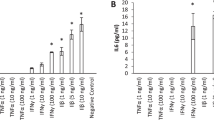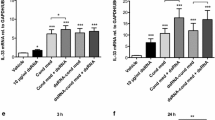Abstract
RANTES is a chemokine with eosinophil attractant and activating activities. This study was undertaken to determine whether primary cultures of human nasal and primate bronchial epithelial cells produce RANTES and the effect of various cytokines and dexamethasone on the release of this chemokine. Nasal epithelial cells from 32 patients (HNE) and bronchial epithelial cells from 17 Macaca nemestrina monkeys (PBE) were cultured in vitro for 24 to 72 h with LPS, TNF-α, IL-1β, IFN-γ and TNF-α combined with IFN-γ and/or dexamethasone at 10 to 1000 µg/ml. Culture supernatants were assayed for RANTES by ELISA. RANTES synthesis was measured by immunoprecipitation. HNE and PBE released modest constitutive amounts of RANTES (350 to 1000 pg/ml) which did not increase with time in culture. Release of RANTES was stimulated by all activators except LPS in a time-dependent manner, with the greatest synthesis induced by the combined addition of TNF-α and IFN-γ. The combination of these activators also increased RANTES synthesis as determined by immunoprecipitation. Dexamethasone at 100 and 1000 µg/ml produced significant inhibition of stimulated RANTES release. These data indicate that normal nasal and bronchial epithelial cells release RANTES which is upregulated by various cytokines and inhibited by dexamethasone. The enhanced release is due to stimulation of both synthesis and secretion. Production of RANTES by epithelial cells could contribute to the inflammation that characterizes the respiratory tract in asthma and rhinitis and downregulation of RANTES by glucocorticoids may be one mechanism of the therapeutic effect of these agents.
Similar content being viewed by others
References
Aizawa T, Sekizawa K, Aikawa T et al. Eosinophil supernatant causes hyperresponsiveness of airway smooth muscle in guinea pig trachea. Am Rev Respir Dis. 1990;142:133–7.
Alam R, Stafford S, Forsythe P et al. RANTES is a chemotactic and activating factor for human eosinophils. J Immunol. 1993;150:3442–7.
Alam R, York J, Boyars M et al. Increased MCP-1, RANTES, and MIP-1a in bronchoalveolar lavage fluid of allergic asthmatic patients. Am J Respir Crit Care Med. 1996;153: 1398.
Altman LC, Gleich GJ. Eosinophils. Immunol Allergy Clin North Am. 1990;10(2):263–71.
Ayars GH, Altman LC, McManus MM et al. Injurious effect of the eosinophil peroxidase-hydrogen peroxide-halide sys-tem and major basic protein on human nasal epithelium in vitro. Am Rev Respir Dis. 1988;40:125–31.
Bascom R, Pipkorn U, Lichtenstein LM, Naclerio RM. The influx of inflammatory cells into nasal washings during the late response to antigen challenge: effect of systemic steroid pretreatment. Am Rev Respir Dis. 1988;138:406–12.
Berkman N, Robichaud A, Krishnan VL et al. Expression of RANTES in human airway epithelial cells: effect of corti-costeroids and interleukin-4,-10 and-13. Immunology. 1996;87:599.
Bousquet J, Chanez P, Lacoste JY et al. Eosinophilic inflamma-tion in asthma. N Engl J Med. 1990;343:1514–5.
Davies RJ, Wang JH, Trigg CJ, Devalia JL. Expression of granulocyte/macrophage-colony-stimulating factor, inter-leukin-8 and RANTES in the bronchial epithelium of mild asthmatics is down-regulated by inhaled beclomethasone dipropionate. Int Arch Allergy Immunol. 1995;107:428–9.
Ebiswa M, Yamada T, Bickel C, Klunk D, Schleimer RP. Eosinophil transendothelial migration induced by cyto-kines. III. Effect of the chemokine RANTES. J Immunol. 1994;153:2153–60.
Holgate ST, Roche WR, Church MK. The role of the eosinophil in asthma. Am Rev Respir Dis. 1991;143:S66–70.
Kameyoshi Y, Dorschner A, Mallet AI, Christophers E, Schroder JM. Cytokine RANTES released by thrombin-stimulated platelets is a potent attractant for human eosino-phils. J Exp Med, 1992;176:587.
Kenney JS, Masada MP, Eugui EM, DeLustro BM, Mulkins MA, Allison AC. Monoclonal antibodies to human recom-binant interleukin 1 (IL-1)β; quantitation of IL-1β and inhibition of biological activity. J Immunol. 1987;138: 4236–42.
Kenney JS, Baker C, Welch MR, Altman LC. Synthesis of interleukin-1α, interleukin-6, and interleukin-8 by cultured human nasal epithelial cells. J Allergy Clin Immunol. 1994;93:1060–7.
Konno S, Gonokami Y, Kurokawa M et al. Cytokine concen-trations in sputum of asthmatic patients. Int Arch Allergy Immunol. 1996;109:73. Kwon OJ, Jose PJ, Robbins RA, Schall TJ, Williams TJ, Barnes PJ. Glucocorticoid inhibition of RANTES expression in human lung epithelial cells. Am J Respir Cell Mol Biol. 1995;12:488–96.
Laemmli UK. Cleavage of structural proteins during the assembly of the head of bacteriophage T4. Nature. 1970; 227:680.
Marini M, Vittori E, Hollemborg J, Mattoli S. Expression of the potent inflammatory cytokines, granulocyte-macrophage colony-stimulating factor and interleukin-6 and interleu-kin-8, in bronchial epithelial cells of patients with asthma. J Allergy Clin Immunol. 1992;89:1001.
Manni A, Kleimberg J, Ackerman V, Bellini A, Patalano F, Mattoli S. Inducibility of RANTES mRNA by IL-1β in human bronchial epithelial cells is associated with increased NF-kB DNA binding activity. Biochem Biophys Res Com-mun. 1996;220:120.
McManus MS, Altman LC, Koenig JQ et al. Human nasal epithelium: characterization and effects of in vitro exposure to sulfur dioxide. Exp Lung Res. 1989;15:849–65.
Miller D, Krangel M. Biology and biochemistry of the chemo-kines: a family of chemotactic and inflammatory cytokines. Crit Rev Immunol. 1992;12:17–46.
Naclerio RM. Allergic rhinitis. N Engl J Med. 1991;325:860–9.
Rot A, Krieger M, Brunner T, Bischoff SC, Schall TJ, Dahin-den CA. RANTES and macrophage inflammatory protein 1α induce the migration and activation of normal human eosinophil granulocytes. J Exp Med. 1992;176:1489–95.
Schall TJ. Biology of the RANTES/SIS cytokine family. Cyto-kine. 1991;3:165–83.
Sousa AR, Lane SJ, Nakhosteen JA, Yoshimura T, Lee TH, Poston RN. Increased expression of the monocyte chemo-attractant protein-1 in bronchial tissue from asthmatic subjects. Am J Respir Cell Mol Biol. 1994;10:142–7.
Stellato C, Beck LA, Gorgone GA et al. Expression of the chemokine RANTES by a human bronchial epithelial cell line. J Immunol. 1995;155:410–8.
Wang JH, Devalia JL, Xia C, Sapsford RJ, Davies RJ. Expres-sion of RANTES by human bronchial epithelial cells in vitro and in vivo and the effect of corticosteroids. Am J Respir Cell Mol Biol. 1996;14:27.
Zeck-Kapp G, Kapp A. Subcellular mechanisms of eosinophil degranulation: the role of RANTES, interleukin-5 and tumor necrosis factor-α. Int Arch Allergy Immunol.1995}; 107}
Author information
Authors and Affiliations
Rights and permissions
About this article
Cite this article
Altman, G., Altman, L., Luchtel, D. et al. Release of RANTES from nasal and bronchial epithelial cells. Cell Biol Toxicol 13, 205–213 (1997). https://doi.org/10.1023/A:1007318514715
Issue Date:
DOI: https://doi.org/10.1023/A:1007318514715




